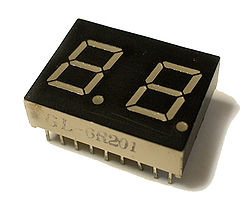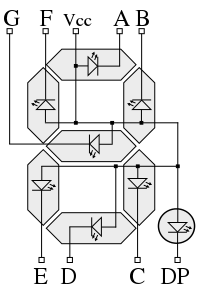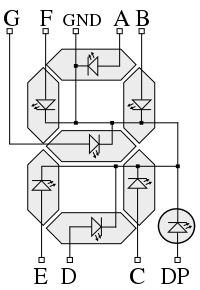A seven-segment display (SSD) is a display device packaged in a single IC chip and composed of a group of seven bar-shaped LEDs. Some seven-segment displays may come with a decimal point (DP). Different numbers and letters may be formed by powering selected LED elements. SSDs come in various packages and pin arranges.
Configurations[edit]
There are two basic configurations of seven-segment displays: common cathode (CC) and common anode (CA).
Common Anode[edit]
A common anode seven-segment display is one where the anode leads of all the LEDs are tied together. In a CA SSD, power must be supplied to anode that is common to all the segments. Appropriate segments can be lit up by applying ground to them.
Common Cathode[edit]
a Common cathode seven-segment display is one where the cathode leads of all the LEDs are tied together.
Basics[edit]
- Further information: Representing Letters
The various numbers (and possibly A-F) can be displayed by simply powering the correct segments by either connecting GND or Vcc depending on your configuration. The usage of displaying various words on a 7-segment display is possible but is generally highly discouraged.
| Digit | BCD | 7-Segments | abcdefg | gfedcba | Display | Reference | |||||||||
|---|---|---|---|---|---|---|---|---|---|---|---|---|---|---|---|
| D | C | B | A | a | b | c | d | e | f | g | |||||
| 0 | 0 | 0 | 0 | 0 | 1 | 1 | 1 | 1 | 1 | 1 | 0 | 0x7E | 0x3F | |

|
| 1 | 0 | 0 | 0 | 1 | 0 | 1 | 1 | 0 | 0 | 0 | 0 | 0x30 | 0x06 | | |
| 2 | 0 | 0 | 1 | 0 | 1 | 1 | 0 | 1 | 1 | 0 | 1 | 0x6D | 0x5B | | |
| 3 | 0 | 0 | 1 | 1 | 1 | 1 | 1 | 1 | 0 | 0 | 1 | 0x79 | 0x4F | | |
| 4 | 0 | 1 | 0 | 0 | 0 | 1 | 1 | 0 | 0 | 1 | 1 | 0x33 | 0x66 | | |
| 5 | 0 | 1 | 0 | 1 | 1 | 0 | 1 | 1 | 0 | 1 | 1 | 0x5B | 0x6D | | |
| 6 | 0 | 1 | 1 | 0 | 1 | 0 | 1 | 1 | 1 | 1 | 1 | 0x5F | 0x7D | | |
| 7 | 0 | 1 | 1 | 1 | 1 | 1 | 1 | 0 | 0 | 0 | 0 | 0x70 | 0x07 | | |
| 8 | 1 | 0 | 0 | 0 | 1 | 1 | 1 | 1 | 1 | 1 | 1 | 0x7F | 0x7F | | |
| 9 | 1 | 0 | 0 | 1 | 1 | 1 | 1 | 1 | 0 | 1 | 1 | 0x7B | 0x6F | | |
| A | X | X | X | X | 1 | 1 | 1 | 0 | 1 | 1 | 1 | 0x77 | 0x77 | | |
| b | X | X | X | X | 0 | 0 | 1 | 1 | 1 | 1 | 1 | 0x1F | 0x7C | | |
| C | X | X | X | X | 1 | 0 | 0 | 1 | 1 | 1 | 0 | 0x4E | 0x39 | | |
| d | X | X | X | X | 0 | 1 | 1 | 1 | 1 | 0 | 1 | 0x3D | 0x5E | | |
| E | X | X | X | X | 1 | 0 | 0 | 1 | 1 | 1 | 1 | 0x4F | 0x79 | | |
| F | X | X | X | X | 1 | 0 | 0 | 0 | 1 | 1 | 1 | 0x47 | 0x71 | | |
In-code decoding can be done easily using a simple lookup table such as the one below:
const unsigned char seven_seg_digits_decode_abcdefg[16]=
{
/* 0 1 2 3 4 5 6 7 */
0x7E, 0x30, 0x6D, 0x79, 0x33, 0x5B, 0x5F, 0x70,
/* 8 9 A B C D E F */
0x7F, 0x7B, 0x77, 0x1F, 0x4E, 0x3D, 0x4F, 0x47
};
const unsigned char seven_seg_digits_decode_gfedcba[16]=
{
/* 0 1 2 3 4 5 6 7 */
0x3F, 0x06, 0x5B, 0x4F, 0x66, 0x6D, 0x7D, 0x07,
/* 8 9 A B C D E F */
0x7F, 0x6F, 0x77, 0x7C, 0x39, 0x5E, 0x79, 0x71
};
Hardware Decoders/Drivers[edit]
| This section is empty; you can help add the missing info by editing this page. |


